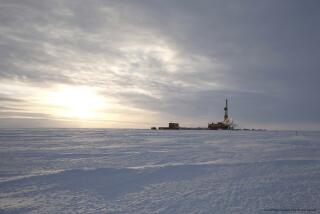Tlingit Indians’ Last Stand in Alaska
- Share via
SITKA, Alaska — Signs of struggle lie buried under a grassy opening in a mist-shrouded forest of hemlock and spruce.
Archeologists at the Sitka National Historical Park recently unearthed musket shot and cannonballs in this quiet glade where they believe a clan of Tlingit Indians, called the Kiks. adi, built a wooden palisade fort and held off Russian attackers for six days in October 1804, until their ammunition was spent.
On the sixth night, as the story goes, the Russians on the gunboat Neva heard a mournful ceremonial song rising from the fort. By morning, some 800 women, children, elders and warriors were gone, bound for the far side of their island home and to an island beyond.
The strategic retreat from the land they had held for generations marked the end of open Tlingit resistance to the Russians and ushered in what history books describe as the Russian America period in Alaska.
Standing at the edge of the glade, Irene Jimmy, a Tlingit (pronounced CLING’-kit) elder from Sitka and a descendant of the warring Kiks. adi clan, remembers hearing about the Battle of Sitka as a child. But she learned less about the details of the conflict than about the powerful emotions that still roil inside her people.
“I got little bits of information from my mother, but it was such a sad, sad thing for her to repeat it,” she said. “She would get tearful when she talked about it.”
Though clan members have been long silent about the events, Jimmy and others are now cooperating with the National Park Service as it surveys the area to pinpoint the exact location of the fort.
They also are working with anthropologists in Alaska’s capital, Juneau, who are merging the Kiks. adi’s oral histories with Russian written accounts of the battle.
Clan leader Donald “Duck” Didrickson said it was important, before any more history was lost, to preserve the clan’s cultural heritage for future generations. “If you don’t pass it on, it’ll slip by you,” he said.
The hostilities that led to the 1804 battle had been building for years.
Under Alexander Baranov and the Russian-American Co., Russian fur traders started moving into Southeast Alaska in 1799, having depleted the sea otter and fur seal populations in the Aleutian and Kodiak islands.
Baranov built a permanent settlement in Sitka for his traders and their conscripted Aleuts and they began to trade with the Tlingits. But the relationship was an uneasy one that steadily worsened.
In 1802, the Tlingits attacked the Russian outpost and burned it to the ground. Expecting retaliation, the Tlingits built a fort on the beach where rocky shoals stretching far into the water would prevent Russian warships from drawing close.
Urey Lisiansky, commanding officer of the Neva, drew a map of the fort that showed 14 partially buried houses surrounded by a palisade of saplings. The barricade was built at an angle and anchored in the ground. That gave it flexibility and accounts say that cannonballs simply bounced off its seaweed-slathered surface.
A 10-pound cannonball, encrusted in rust and now sitting in an artifacts box at the park’s visitor center, was discovered buried under tree roots last year by archeologists with metal detectors.
Visiting scientists from the Park Service’s Midwest Archeological Center in Nebraska have been probing the ground with high-tech equipment such as ground-penetrating radar and a magnetometer to analyze disturbances to the magnetic field. They also have dug hundreds of “good old-fashioned shovel holes,” archeologist William Hunt said.
About 2 feet deep and 2 feet wide, the holes are “a quick and dirty way of looking under the ground,” Hunt said. “This gives us a giant idea of what’s there and we can come back in later years for more specific information.”
The crews sift the dirt through screens to extract booty such as stone tools, an iron mallet and charcoal from old campfires. The park has shared these finds with the Kiks. adi, who have helped to identify some of the objects.
They haven’t yet pinpointed the exact location of the fort. Though historical accounts say the Kiks. adi built their fort on a beach, scientists are fairly sure it is in the vicinity of the rain forest glade.
That’s because the land has changed over the years, both through human activities -- including gravel mining during World War II -- and a natural phenomenon called isostatic rebound. Across Southeast Alaska, what was once waterfront has become uplands, springing back like a sponge when released from the weight of receding glaciers. A nearby river may have shifted as well, causing erosion at the site.
Gene Griffin, chief resource manager at the park, said analyzing the data was tricky.
“It’s not like, ‘Oh my gosh, there’s the wall and there are the houses all in a row that match Lisiansky’s map to a T.’ But the concentration of evidence does give credence that that is the location,” he said.
Clan leader Didrickson often visits the spot with his 3-year-old granddaughter. They feed the squirrels and look at the 35-foot totem pole carved with raven and other creatures representing the Kiks. adi clan and those who fought with them.
Someday he will tell her the stories about the conflict and about the choice his people made to retreat to survive and return one day to their land.
If he stands very still, Didrickson can feel the thunder of battle.
“You can feel the vibrations in the ground,” he said. “For me, it’s easy to live it because I am Kiks. adi.”
More to Read
Sign up for Essential California
The most important California stories and recommendations in your inbox every morning.
You may occasionally receive promotional content from the Los Angeles Times.













